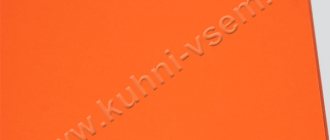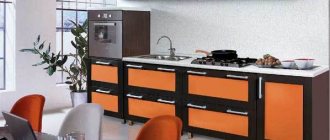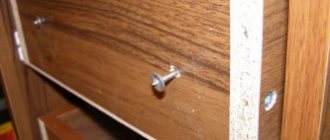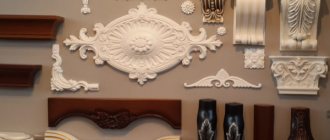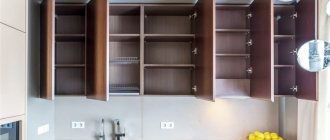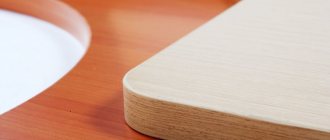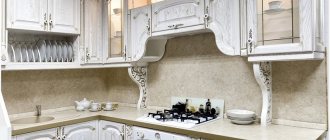Wood milling of MDF facades
MDF (from the English Medium Density Fiberboard) is a board made of fine wood chips pressed with a binder (usually urea resin). Such a board has the properties of hard wood, but lasts much longer and is easier to process, including milling, due to the constancy of its structure. Using milling of MDF facades allows you to obtain aesthetically attractive decorative elements of a furniture facade that can visually transform your kitchen. Milling MDF facades coupled with the use of PVC film coatings makes it possible to achieve a huge variety of facade decors and increase the consumer value of finished products. We offer our partners a wide variety of ready-made milling of MDF facades, and are also ready to consider proposals for the introduction of new milling options in our production at the request of our regular customers.
What is MDF
This abbreviation is taken from the English source. This is the common name for fiberboards, the density of which is characterized as medium. The initial raw material for production is finely dispersed shavings. The production method is dry pressing at high temperatures and fairly high pressure.
Lignin and resins (mainly urea) modified by the addition of melanin are used as a binder. This makes it possible to reduce formaldehyde emissions to a value comparable to that of natural wood.
The resulting material perfectly resists the effects of pathogenic microflora, water, and is fire resistant. The strength of MDF board is almost twice that of chipboard. Density is set in the range (600-800) kg/m3.
Machines for milling MDF facades
Our production uses ARTISMAN-S3204 CNC milling machines in its work.
This allows you to mill MDF facades, from solid wood and other materials, to produce simple and complex facades, and engraving (applying drawings, inscriptions and ornaments). All parts manufactured on this machine can have threads of any degree of complexity. It can also be used for the manufacture of platbands, panels, balusters, frames, inlaying, curved cutting, cutting out letters and other similar works of high complexity.
Milled facades - some options
Palermo more details from 5500 rub.
Palermo Piatto more details from 5500 rub.
Autentico more details from 5500 rub.
Integrato more details from 5500 rub.
Ricco more details from 5500 rub.
Rettangolo more details from 5500 rub.
Facades painted with milling all options
Stages of milling MDF facades
Each milling operation involves sequential milling of the corners, edges and surface of the part. These operations can be performed in various technological sequences depending on the number and direction of the cutter passes. After all three stages of facade milling are completed, the MDF part is prepared for membrane-vacuum processing (recesses are drilled on the back side of the facade part for better diffusion of the sucked air). After milling is completed, the finished MDF facade is sent for further processing (puttying and cleaning of irregularities and covering with PVC film).
Hand tool attachments for MDF facades
In small factories for the production of furniture facades from MDF, the vast majority of the grinding process is carried out manually. This is understandable; as a rule, there is no money for a large machine. Yes, it is not practical for small industries. But manual labor can be mechanized! And the first step in such mechanization can be attachments for hand tools. So, attachments for hand tools. They can be used to sand both MDF and primer. To avoid many problems when using sanding brushes and improve the quality of sanding, we strongly recommend reading this article.
Unfortunately, there is no universal brush system. Each has its pros and cons. If you only need to sand milled MDF facades, you will need a maximum of 3 systems.
The ends of the facades are made of MDF. The ROQ system works great on this surface. Due to the use of an additional supporting brush, the contact area on the abrasive will be 10-13mm. This allows you to increase productivity and improve the quality of the machined surface. The abrasive changes as it wears. As for the brushes, the latter can withstand multiple changes of abrasive - due to this, the cost of grinding per linear meter is reduced significantly! These attachments can be used on a drill or screwdriver, but it is not always convenient to hold the façade with one hand and the screwdriver with the other hand. You can do it as shown here. A little ingenuity and a simple drill turns into a mini machine. Alternatively, you can use a drilling machine. 350-600 revolutions are enough, no more is needed, lint from MDF is easily removed. Since the milling cutter always lays the pile in one direction, it is necessary to start sanding against the pile. Ideally in both directions. But this is often difficult, so it is considered sufficient against lint. The most difficult thing is to learn not to knock down the corner of the facade when starting to grind from the corner, but as practice shows, you can “get the hang of it” in 5-10 minutes.
Internal straight milling. The same bushing of the ROQ system is used, but it is equipped with other brushes for complex profiles. In this case, we recommend using a brush height of 65mm and abrasive height of 70mm. The higher the brush, the softer it works. With such a brush height, it is possible to process profiles with height differences of up to 25 mm, which is clearly excessive for facades, but soft sanding of MDF without changing the geometry is important to us. RPM 300-500. Since in internal milling the cutter leaves multidirectional pile on different sides of the milling, the internal milling must be sanded in both directions. If the milling is simple, then the entire internal milling can be sanded with this set. But if the milling is complex, the specified combination of sleeve and brushes will not allow grinding in the corners - there you can very quickly change the geometry of the milling (knock off the corners), since grinding goes across the milling. Rotation 350-600 rpm.
If internal milling is complex, then it is advisable to grind the corners using the T90H end sleeve, this is an end sleeve with a diameter of 90 mm. You should not grind along the milling line, but move the rotating bushing with brushes along the milling line in zigzags. This allows you to sand the MDF profile in all directions. The performance of this system is slightly lower. If you grind straight milling cuts, it will take several times more time compared to the second option. Therefore, it is advisable to use it at corners, and to use a radial bushing with high brushes for straight milling. Rotation 250-400 rpm.
By default, we use an abrasive with a blade width of 3mm (for ends with a radius of better than 5mm), but in some cases, when there are small shelves or right internal corners, it is advisable to additionally alternate it with a 2mm abrasive blade or abrasive nylon
. The wide abrasive blade simply physically cannot reach the surface in a hard-to-reach place, and the design of the abrasive nylon fiber allows this to be done with ease. We always use P240 grain by default. When sanding MDF, it is not advisable to use a coarser grain - there is a high risk of changing the geometry of the profile and after P180 (and coarser) more pile rises, especially when primer is applied). If the MDF is dense, then you can sand it with P320 grain, since on denser MDF the pile is shorter and there is less of it. In some exceptional cases, it is necessary to use P180 on the ground, but this is only if there are violations of the simple rules for processing MDF.
MDF milling
MDF boards are extremely popular in the manufacture of kitchen furniture for individual projects. At the same time, individuality is important not only in size, but also in the design of the facade itself. Various speed modes and milling with cutters with different sections make it possible to decorate MDF facades with design drawings that make each furniture set unique.
Milling stages
Milling MDF facades includes several stages. It is worth noting that depending on the passage of the cutter and the likelihood of chipping the edge of the workpiece, the stages are implemented in any order.
The following stages of the process are distinguished:
Milling of MDF facades at corners. This process ensures a more attractive appearance and sharp edges that can cause injury during use of the finished product. This operation should be performed with a cutter having a cutting edge radius of 2-3 mm. When working with tabletop corners, you can work with larger radii from 10 mm. It is important not to leave large chips, which become more difficult to eliminate at further stages of working with blanks for milling MDF facades along the edges. This procedure can be performed with different cutters at the discretion of the designer. The chamfer is removed, first of all, in order to eliminate sharp edges that are unacceptable for future processing and use. With the help of competent selection of the cutter shape, its radius and the angle of milling of facades, you can achieve the desired aesthetic appearance of the future product. Types of milling of MDF facades can be different. On MDF facades it is appropriate to use shaped cutters; for light shades it is better to process the edges with cutters with small radii; and if you are going to use “metallic” shades, then the chamfer radius can be increased.
Which cutters are recommended for processing facades made from MDF
Chamfering (edging) and finishing the contour defined by pre-made templates are carried out with special cutters.
A significant number of models of milling machines produced in recent years involve the use of end mills with cylindrical ends. But their designs make it possible to replace the chuck supplied at the factory in order to use cutters of other shapes.
Milling of facades involves the use of a cutter for the purpose of:
- chamfering (edge processing);
- performing profiling;
- engraving;
- execution of decorative elements;
- arrangement of holes (drilling).
Types of cutters most commonly used
Among the tools that are in high demand when processing MDF, the following types of cutters should be noted:
- grooved – ensure leveling of the surface of the facade parts of large-sized MDF boards (grinding furniture panels, tabletops);
- V-shaped slotted cutters. Required if it is necessary to perform volumetric (3D) processing, be it engraving or milling.
This tool provides cutting edges, cutting panels without chipping, milling V-grooves, and processing edges (an angle of 45 degrees is displayed).
- Spherical - used at the stage of basic processing of wooden (option, MDF) panels;
- two-thread (their sharpening has a memorable name, “fishtail”).
This tool is in demand for clean cutting of workpieces made from laminated MDF (this eliminates the occurrence of chips). In addition, the mentioned cutters can be used for rough finishing of material (on machines without vacuum clamping), if it is necessary to drill panels.
When choosing the types and required number of cutters to perform the upcoming work, the complexity of the project must be taken into account.
Example. If a part is put on a conveyor, it is enough to have a basic set of tools. But design sketches with proper quality will only be possible if you have a variety of cutters (the more varied the assortment, the better the result).
